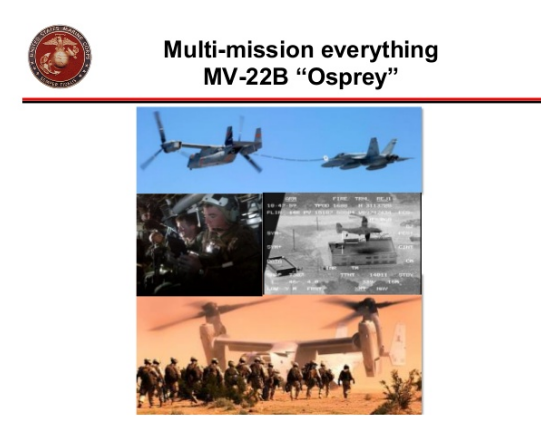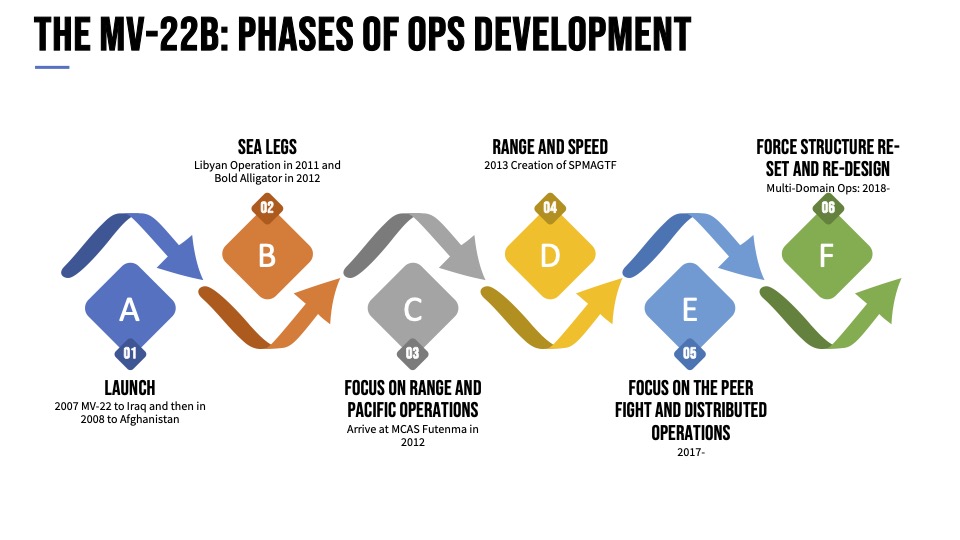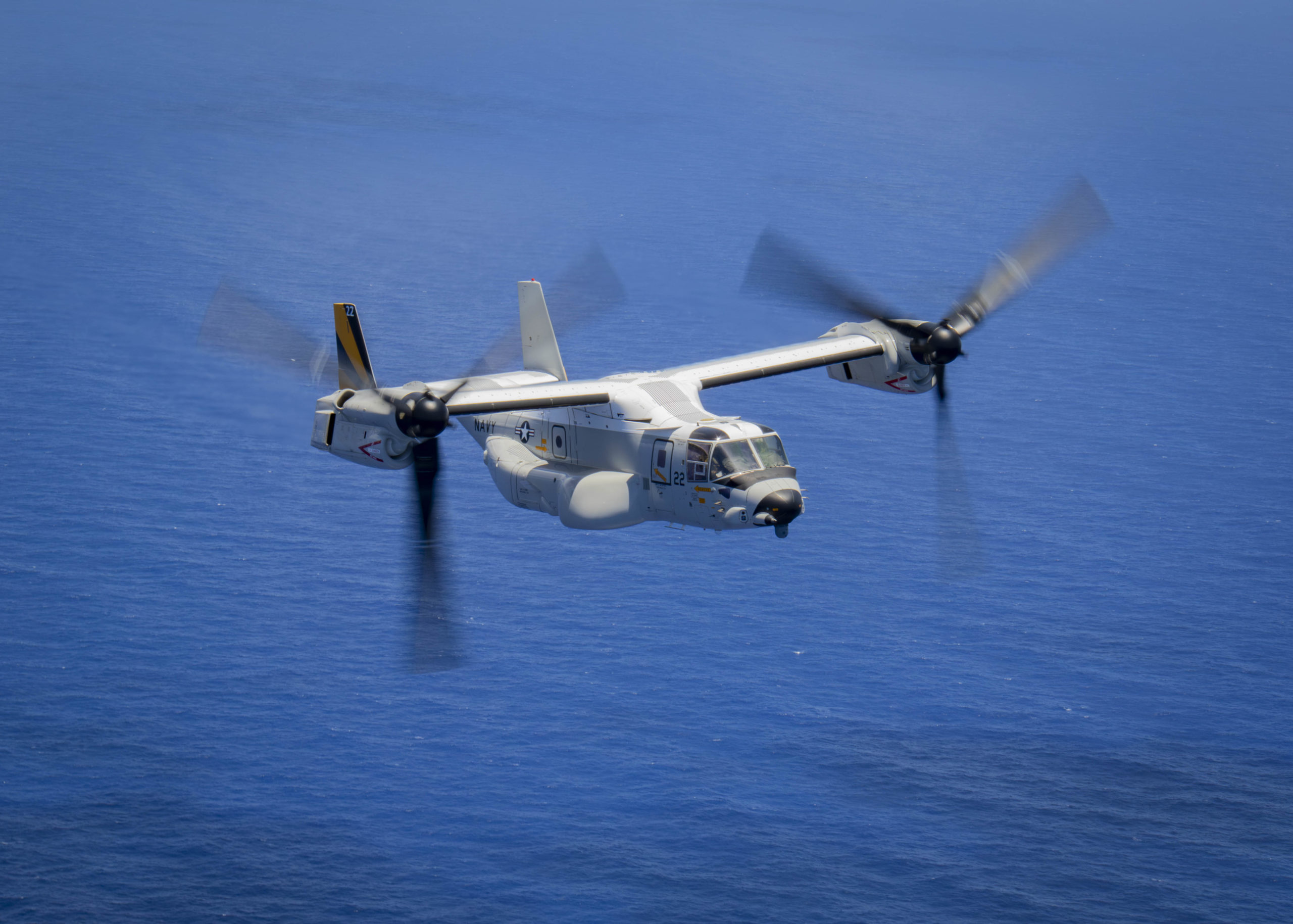The Timeline for the Tiltrotor Enterprise: A Con-Ops Perspective (Part Four)
The focus on distributed operations – Maritime DO, the USMC EABOs, and the Air Force agile combat employment – fits the capabilities of the Osprey – with its speed, range, air refuelable capability – perfectly. It is both an enabler of distributed operations and a benefactor from such operations. It can create distributed points of operation, and can leverage them.
The payload revolution associated with distributed operations is enabling the emergence of a kill web force. Ed Timperlake and I have written a book on the coming of the maritime kill web force and explained in detail the nature of such operations.
But a key to being able to do so is the C2-ISR revolution which can proliferate payloads to be inserted in air, ground, space and maritime assets which can cross-support the operations of a distributed force.
I first witnessed the Osprey being fitted for a new mission with a new payload when I visited the Boeing plant in Philadelphia in. 2015 with Murielle Delaporte. Specifically, they were working on the ability of the Osprey to operate as a tanker. And during that visit to the Boeing V-22 Osprey, the Boeing team explained the range of possibilities for the Osprey adding multi-mission roll-on-roll off capabilities.
And in 2016, in a presentation in Australia to the Sir Richard Williams Foundation, LtGen “Dog” Davis talked about the transformation of the Osprey into the multi-domain world. When Lt. General Davis, the Deputy Commandant of Aviation spoke at the Williams Foundation seminar on new approaches to air-land integration, he described a key aspect of the evolving Marine Corps approach with their air assets as “multi-mission everything”.
Technology is important to this effort, and he highlighted that the Osprey being brought into the force was a generator of “disruptive change,” but the kind crucial to real combat innovation.
“But change is difficult; and the critics prevalent.”
He noted: “If we held this conference 12 years ago, and the room was filled with Marines we would hear about all the things the Osprey could not do and why we should not go ahead. “If we brought those same Marines into the conference room now, they would have amnesia about what they thought then and press me to get more Ospreys and leverage it even more.”
But it is not just about technology – it is about “equipping Marines, not manning the equipment.”
His point was that you needed to get the new equipment into the hands of the Marines at the earliest possible moment, because the young Marines innovate in ways not anticipated when the senior leadership gets that equipment to them.

As the emphasis on multi-mission capability to enable a multi-domain force accelerates, the Osprey is key enabler of this strategic force structure shift. In an interview I did in 2023, this shift was a core emphasis of this Marine Corps leader’s perspective.
Colonel Marvel, the CO of MAG-39, located at Camp Pendleton, underscored that expanding the mission set for the Navy’s CMV-22B was certainly possible but was not in his domain of responsibility. But the USMC is clearly expanding the payloads carried by the MV-22B which supports distributed operations, and if the three services which operate the aircraft found ways to expand their ability to cross-service each other’s aircraft, they would be able to enhance such operations.
As Col Marvel put it: “The Osprey provides unique speed and range combinations with an aircraft which can land vertically. It is a very flexible aircraft which could be described as a mission-kitable aircraft. The Osprey has big hollow space in the rear of the aircraft that can hold a variety of mission kits dependent on the mission which you want the aircraft to support.”
He emphasized that with a variety of roll-on roll-off capabilities with different payloads. “We can add the specialists in the use of a particular payload along with the payload itself to operate that payload, whether kinetic or non-kinetic, whether it is a passive or active sensor payload. We need to stop thinking about having to put the command of such payloads under the glass in the cockpit, and control those payloads with a tablet.”
Col Marvel underscored that the Marines when deployed are engaged in presence missions. How then best to use their presence to deliver the desired effect? And given the Marines are operating across the spectrum of warfare, and that spectrum itself is changing, which payloads are most relevant to the mission? This means that “we need to maximize the payload utility of our platforms.”
He provided a number of examples of different payloads which they are working with from USVs to a variety of passive and active sensors. Kill webs need to be sustained and Ospreys can provide both fuel and ordinance to platforms throughout the extended battlespace. For example, Ospreys can bring fuel and ordinance to a FARP (forward arming and refueling point) and support P-8 operations, for example.
Ospreys can palatize torpedoes and engage them in the battlespace. They can provide key parts of the network of sensors that make a distributed forces’ domain C2 and fires control picture. With the proper payload, Ospreys can maintain contact with surface and subsurface forces to help build a common tactical operating picture.
With the Navy developing the CMV-22B variant of the Osprey, the multi-mission capabilities of the aircraft are clearly being expanded as well. In early January 2023, I visited, Captain Sam Bryant, Commander, Fleet Logistics Multi-Mission Wing in North Island, and he underscored the Navy’s interest in broadening the CMV-22Bs role beyond the legacy Carrier on Demand function.
As I noted in that interview: “Captain Bryant reported that the U.S. Pacific Fleet Commander, Admiral Paparo, was pleased with the initial deployments, but feels that the Osprey can do much more in its role in evolving fleet concepts of operations.
“The aircraft provides an important support for, but more than that, stimulant for the shift in con-ops whereby the Navy focus on distributed operations which itself is in an experimental development and growth phase and intersects with the USAF’s approach to agile combat employment. In other words, the reshaping of joint and coalition operations is underway which focuses upon distributed task forces which can deliver enhanced lethality and survivability.”
I then followed up that session with Bryant by a visit to PACFLEET. And this is what I learned during my April 2023 visit. A senior U.S. Navy Admiral commented: If we are going to have distributed maritime operations, we better have the ability to support, battle damage repair, sustainment, and medical services provided at way more rapid than 20 knots.”
As the Navy needed to augment significantly over time its intra-theater logistics support, they are starting with the replacement of the C-2A Greyhound with the CMV-22B tiltrotor aircraft. The Admiral described this as a shift from a limited specialized support asset to having a distributed fleet support asset which provides for intra-theater logistics, a priority need.”
The Admiral commented: “With an Osprey, we have a bigger footprint so that we are no longer a low density, high demand asset. Because the COD was a small, exquisite capability that we’re only going to use for one type of platform, we had small numbers which in turn affected availability of the asset. With the Osprey, we have all manner of platforms we can land on or service stations we can operate from. We are not committed to a tail hook and its limitations. This gives us logistics capability which allows us to make the choices about who needs to be resupplied and at what time, day, or night.”
The CMV-22B provides an important stimulant for the shift in con-ops whereby the Navy‘s experimentation with distributed operations intersects with the U.S. Air Force’s approach to agile combat employment and the Marine Corps’ renewed interest in Expeditionary Advanced Base Operations (EABO).In other words, the reshaping of joint and coalition maritime combat operations is underway which focuses upon distributed task forces capable of delivering enhanced lethality and survivability.”
And now with the US Army becoming a stakeholder in the Tiltrotor Enterprise, they will add their own demands on the enterprise but also be able to leverage many years of operational experience by the other stakeholders. And with the emphasis on an open architecture for the Army tiltrotor aircraft, a “mission-kitable” aircraft is assured.
In this 2020 article by Steve Lamb, the Army approach was explained as follows:
Whether performing transport, logistics, strike or reconnaissance duties, helicopters and tilt-rotor aircraft greatly multiply the effectiveness of ground forces. They are a combat multiplier as well as a lifeline in austere environments.
Future Vertical Lift (FVL) will transform the Army’s rotary wing fleet, bringing faster, more lethal and more survivable aircraft to the battlefield.
The heart of this family of aircraft will be the digital backbone, which includes the future attack reconnaissance aircraft (FARA) and the future long-range assault aircraft (FLRAA) for the Army, as well as the attack utility replacement aircraft (AURA) for the Marine Corps. This is a fully integrated, open, safe and secure architecture that will enable true multi-functionality of currently federated systems while providing the Army with the agility to rapidly iterate FVL’s mission systems to outpace the threat. The Army-owned modular, open systems architecture (MOSA) is an advanced and low-risk path to realizing this aspect of the FVL vision.
“Future Vertical Lift will be the most sophisticated rotorcraft to enter military service, with all systems connected by the digital backbone,” said James Conroy, vice president, navigation, targeting and survivability, Northrop Grumman. “Just as a mobile phone relies on an operating system to connect apps and sensors, this digital backbone will allow the next generation of avionics and self-protection systems to work in a unified way.”
With future generations of FVL aircraft planned to operate alongside the enduring fleet of Apaches, Black Hawks and Chinooks, ensuring interoperability and commonality within Army Aviation will also be a top priority. Investments in FVL must enable the enduring fleet to be capable of multi-domain operations concurrently.
And building towards the future for the Army can leverage the many years of operational experience of the Marine Corps, the Air Force and now the Navy, in operating the tiltrotor aircraft. And the Army will itself provide new energy and concepts of operations to the tiltrotor enterprise as it moves forward into the future.

Featured Image: (Aug. 17, 2023) A CMV-22B Osprey, assigned to the “Titans” of Fleet Logistics Multi-Mission Squadron (VRM) 30, returns to Nimitz-class aircraft carrier USS Carl Vinson (CVN 70). Vinson, Carrier Strike Group 1’s flagship, is underway conducting routine operations in the U.S. 3rd Fleet area of operations. (U.S. Navy photo by Mass Communication Specialist 3rd Class Isaiah B. Goessl)

